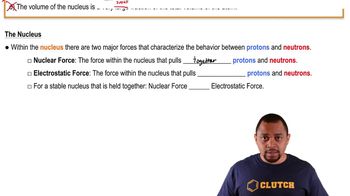Many familiar substances have common, unsystematic names. For each of the following, give the correct systematic name: (a) salt peter, KNO3 (b) soda ash, Na2CO3 (c) lime, (d) muriatic acid, HCl, CaO (e) Epsom salts, MgSO4 (f) milk of magnesia, Mg(OH)2.
Ch.2 - Atoms, Molecules, and Ions
Chapter 2, Problem 114
In what part of the atom does the strong nuclear force operate?
 Verified step by step guidance
Verified step by step guidance1
Step 1: Understand the structure of an atom, which consists of a nucleus containing protons and neutrons, surrounded by electrons in orbitals.
Step 2: Recognize that the strong nuclear force is one of the four fundamental forces in nature, responsible for holding the atomic nucleus together.
Step 3: Identify that the strong nuclear force operates within the nucleus of the atom, acting between protons and neutrons.
Step 4: Note that this force is much stronger than the electromagnetic force that would otherwise cause the positively charged protons to repel each other.
Step 5: Conclude that the strong nuclear force is crucial for the stability of the nucleus, overcoming the repulsive forces between protons.
Key Concepts
Here are the essential concepts you must grasp in order to answer the question correctly.
Strong Nuclear Force
The strong nuclear force is one of the four fundamental forces of nature, responsible for holding protons and neutrons together in the atomic nucleus. It is a short-range force that operates at distances on the order of one femtometer (10^-15 meters) and is significantly stronger than the electromagnetic force, which causes repulsion between positively charged protons.
Recommended video:
Guided course

Effective Nuclear Charge
Atomic Nucleus
The atomic nucleus is the dense central core of an atom, composed of protons and neutrons, collectively known as nucleons. The nucleus contains most of the atom's mass and is held together by the strong nuclear force, which overcomes the repulsive electromagnetic force between the positively charged protons.
Recommended video:
Guided course

The Nucleus
Nuclear Interactions
Nuclear interactions refer to the forces and processes that occur within the atomic nucleus, primarily involving the strong nuclear force and weak nuclear force. These interactions govern the stability of the nucleus, nuclear decay, and reactions such as fusion and fission, which are essential for understanding nuclear chemistry and physics.
Recommended video:
Guided course

Nuclear Binding Energy
Related Practice
Textbook Question
Textbook Question
Because many ions and compounds have very similar names, there is great potential for confusing them. Write the correct chemical formulas to distinguish between (a) sodium carbonate and sodium bicarbonate, (b) potassium peroxide and potassium oxide, (c) aluminum nitride and aluminum nitrite, (d) iron(II) oxide and iron(III) oxide
Textbook Question
Because many ions and compounds have very similar names, there is great potential for confusing them. Write the correct chemical formulas to distinguish between (e) hydride ion and hydroxide ion, (f) magnesium nitride and magnesium nitrite, (g) mercurous chloride and mercuric chloride, (h) cuprous oxide and cupric oxide.
